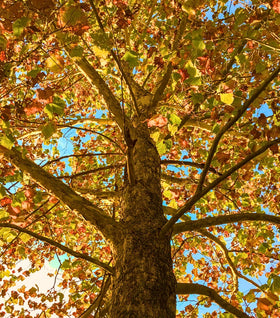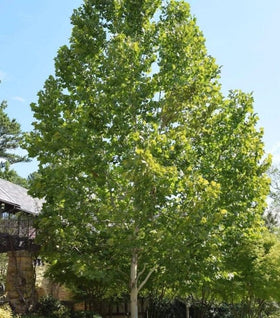Sycamore Trees for Sale Online
Sycamore trees are nationally renowned as beautiful shade trees. These large trees are known for their wide canopies comprised of large lobed leaves, making them ideal for large landscapes where quick shade is required.
What Types of Sycamore Trees Are There?
Sycamore trees, also known as buttonwood or buttonball trees, are recognized for their incredible height, gray-brown camouflage bark, and dark green leaves that turn yellow in the fall. Only a handful of sycamore species are found across North America, but they are all similar in appearance, whether you’re comparing the American Sycamore Tree, Asian or European varieties.
Why Should You Plant Sycamore Trees on Your Property?
American Sycamores or Platanus occidentalis are beautiful trees with long histories in the United States. Named as the largest deciduous tree in the Eastern United States. Sycamores can grow up to 75 to 100 feet tall on average with a similar spread.
These trees can have trunks up to 10 feet in diameter, making them impractical for smaller landscapes but a great addition to parks and larger estates. If you want something sure to create dense shade, this is a great tree to choose from.
On top of their uniqueness, sycamore trees are practical in certain circumstances. They provide incredible shade benefits and are surprisingly easy to care for, considering their size. Just be careful to plant them away from sidewalks, utility lines, and buildings, as their root systems can grow to be extensive.
How Can You Find the Right Sycamore Trees for Your Home?
Sycamores are unique trees that may not suit every garden. If your landscape is limited in size and doesn’t have the room to support a tree with a 10-foot-diameter trunk, it may be best to look at another variety. However, if you own a larger estate or are looking for a landscape tree for a park or other large swath of land, the sycamore may be a good choice.
Sycamore Trees have been planted as street trees for hundreds of years, and the constrictive nature of that environment tends to keep the tree in check as far as height is concerned.
Why is the Bark Peeling on my Sycamore Tree?
Often you will see the reddish-brown outer bark peeling away from the tree, revealing the light brown to gray underneath. This is a normal part of the tree's growth, and there is no need for concern. This is what many consider to be part of the charm of these majestic trees.
How Do You Care for Your Sycamore Trees?
Sycamore trees grow well in many environments across the United States, growing in nearly any soil and under partial to full sun conditions. They prefer deep, rich soil, so it’s best to plant them in an area with well-drained but moist soil. Amend the soil with a tree fertilizer such as Tree Tone by Espoma before planting. Always water your young tree regularly and deeply to keep the soil from drying out as the root system grows.
Sycamore trees are notorious for tolerating wet soil, and if you have an area on the lawn that tends to stay wet, these trees may help keep the area drier.
Once established, young sycamore trees handle drought and other poor conditions with greater endurance, requiring less attention. Continue fertilizing each season and give sycamores a deep soak each month, especially in dry environments. As the tree grows, it should be pruned to remove lower branches, dictating the tree's shape.
How Fast Do Sycamore Trees Grow?
Sycamore trees grow rapidly up to 2 to 3 feet per year once established. Unlike other fast-growing trees, they are long-lived oftentimes living to be well over 100 years old.
Buy Your Sycamore Trees Online
Sycamore trees are a stunning addition to larger landscapes, and with Garden Goods Direct, you can get the perfect quality tree for your yard. As America’s number one online garden center, Garden Goods Direct will help you order your new sycamore tree and offer advice on its care through our easy online ordering solution and accessible nursery experts. We’ll deliver your tree directly to your door and give you the advice you need to get it started.


